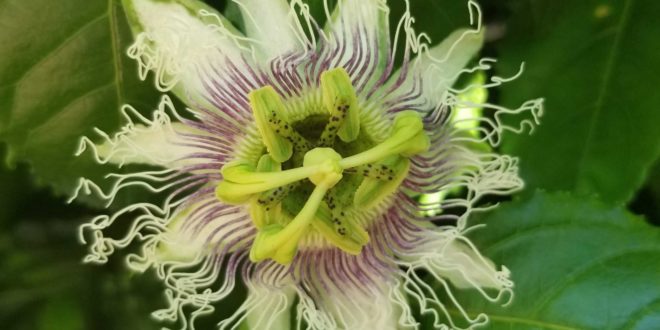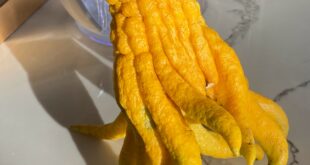With spectacular flowers and tasty fruit, you gotta try growing this passion fruit. This variety is named after Nancy Garrison, a Master Gardener in Santa Clara County. The vine was found in front of an old farm house and handles the cooler winters of our region.
Passion fruit is widely grown and valued throughout the tropics and subtropics. Most Passifloras are vines which can climb to 20 or 30 feet. The fruit varies in color from purple to yellow-orange and in shape from an egg to a tennis ball. Inside its quarter-inch protective rind are numerous small seeds covered by a juicy aromatic, sweet-acidic pulp. The sweeter species are esteemed as a fresh fruit. The seeds are consumed with the pulp. The fruit is more commonly made into juice and often blended with other juices such as orange. The fruit also is used to make excellent ice creams, sherbets, jellies, and pies.
The downside of the passion fruit is that most esteemed species are very frost tender. The best adapted to California of the tropical species, the purple granadilla (P. edulis), is prone to soil diseases. However, there is a yellow form which, though not as sweet, is not subject to these diseases. More importantly, the yellow form can be hybridized with the purple or used as a root stock. Marketwise, the United States can not compete in the production of passion fruit juice, and a demand for the fresh fruit has not been established except for a very limited gourmet business.
Botany
The family Passifloraceae contains about 550 species of which 400 are in the genus Passiflora. Of these all but about 40 are indigenous to tropical and subtropical America. They are commonly found as understory plants in rain forests. The passifloras are herbaceous and shallow rooted. Leaves are usually alternate. The leaf margin can be toothed or entire.
The unusual flowers are the outstanding characteristic of passifloras and many are grown only for their flowers. The flowers are bisexual, colorful, possessing a complex corolla, and a superior ovary on a gynophore. The flowers were named by missionaries who associated them with the Passion or suffering of Christ (the five petals and five sepals with the ten apostles, the corona with the crown of thorns, the five stamens with the five wounds, etc.).
P. edulis bears 2 to 3 inch spherical to ellipsoidal fruits. The fruits have a tough rind with a white pith adhering to the inside surface, about .3 inches in total thickness, and wrinkled when ripe. Inside is the edible portion consisting of many small black seeds on which adheres a juicy orange colored pulp. The flavor is highly fragrant, sub-acid to acid.
The P. edulis has a subspecies, yellow (P. edulis var. flavicarpa). The yellow form is more acid, less frost tolerant, and less prone to disease. In warmer climates the yellow will out-yield the purple, but this does not seem true with most areas in California.
Yellow and purple passion fruit flowers are perfect but self sterile and require insects to achieve fruit set. Flowers of the purple are self-compatible. They blossom in the spring and early summer. Pollen of the yellow will pollinate the purple, but not vice versa. The fruit of both ripen in 7 to 8 weeks.
Although there are many passiflora species that bear excellent fruit, the edulis is the only species that is sufficiently cold hardy to be grown outside of the banana belts in the milder areas of California. More cold hardy species do exist, but the fruit is not generally preferred to the edulis. Included here is a summary of the characteristics of the more important species:
Climatic requirements
The purple edulis is native to southern Brazil, Paraguay, northern Argentina. This area has a humid, near-tropical climate. The yellow edulis subspecies is native to the Amazon basin and perhaps a hybrid of the purple and P. ligularis.
The optimal growing temperatures are 68 to 82 degrees. Passion fruit likes full sun along the coast, but inland full sun should be avoided since it does not like hot, dry heat.
Soil Requirements
Passion fruit grow best in fast draining soils (sandy loam) with a pH 6.5 to 7. Drainage is particularly important for the purple subspecies since it is susceptible to soil diseases. Since the roots of plants are shallow, planting in raised beds can help provide the necessary drainage. The plants benefit from mulching.
Spacing and training
Passion fruit are usually planted on 8 to 12 foot centers and trained on strong supports in a fashion similar to grapes. They are also cordoned on walls or flat trellises.
Watering
Passion fruit require a lot of water, particularly inland. However, careful attention must be paid to watering since overwatering can help further detrimental diseases and underwatering can leave the shallow roots too dry.
Fertilization
Passion fruit require frequent application of balanced fertilizer during growing season. In winter plants may be chlorotic (yellow between the veins of leaves) due to cold soil temperatures.
Pruning
Since the passion vines are vigorous growers, pruning is necessary to keep the plants to a desirable size, to remove tangles, and to remove deadwood. The plants are vigorous and can be pruned anytime; however, pruning just before spring flush is preferred.
Pests and Diseases
The purple passion fruit is subject to fusarium wilt, nematode attack, and crown rot and, therefore, may require replanting every 3 to 4 years. Planting on mounds or ridges is recommended for better drainage. Fungicide sometimes is used on the crown in wet season. The yellow form is resistant to wilt and nematodes and, therefore, is occasionally used as a rootstock for the purple; however, both are subject to Phytophthora cinnamoni. Other possible rootstocks worthy of trial for California are P. caerulea and P. coccinea. Snails will strip leaves if not controlled, and thrips can be a problem on seedlings.
Propagation
Plants can be propagated by seed; however, the progeny are variable. Fresh seeds are far easier to propagate than seeds that are older than a month or two. Seeds should not be exposed to light until they have germinated. Older seeds can be soaked in tea or coffee for at least one day to improve germination. Fresh seeds will germinate in 1 to 3 weeks; older seed may take months. Plants will bear in 2 or 3 years.
An easy method of propagation and one that will preserve characteristics of the parent is by rooted cuttings. Misting or enclosing in a humid atmosphere (a plastic bag enclosing a pot will do for an occasional rooting) improves the success rate. Grafting is also used to propagate purple passion fruit on disease resistant rootstock (P. flavicarpa).
Harvesting and Storage
Fruit can be harvested when it has turned from green to purple or yellow or allowed to drop if gathered from the ground daily. Unrefrigerated fruit will last 2 to 4 weeks, paraffin-coated and refrigerated at 40 to 44 degrees Fahrenheit it may be kept for more than a month.











